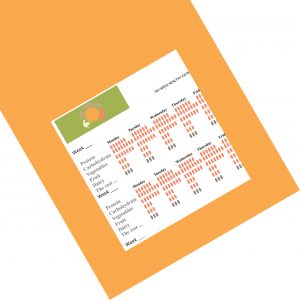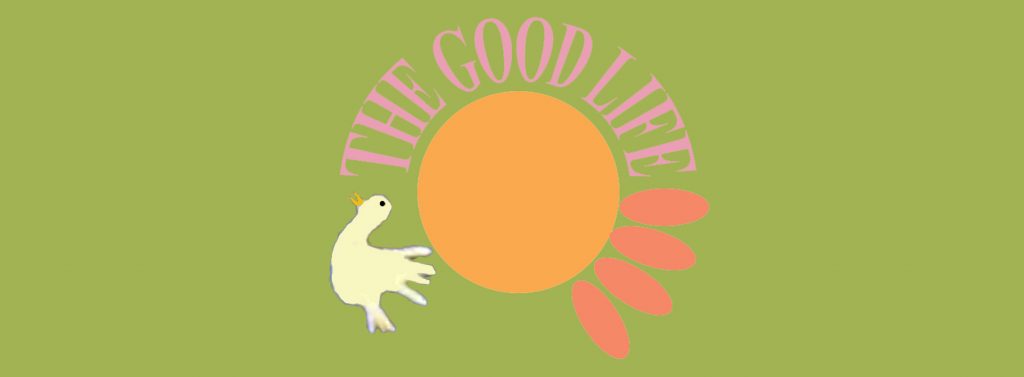Go to The Good Life Week 01 for the start of this series
Here is a simple, yet effective, method for recording your food and drink. Combine this with making notes of your weight, your wellbeing and how active you are. If you start today,by this time next month you will have regained some balance and gleaned a lot of understanding about your diet. I’m recommending that you go dotty – but in a good way. Below you will see a chart that suggests how you can keep track of the balance, quantity and the quality of food in your diet. Simply record the dots. It is based on the Japanese government’s very well researched dietary advice, which in my view is far better than the English version. But you don’t need to eat sushi to follow this regimen.
Remember to eat three roughly equally nutritious meals each day and up to five (small) healthy snacks. Include all foods and drinks in your record. Cross off one dot for every portion or for every 100 calories. Each dot corresponds to one portion of cooked or prepared food. So, a fried egg = a boiled egg = scrambled egg. Each portion, except vegetables, is about 100 calories. Vegetables are very variable, and often much lower than 100 calories per portion.

Choose from S, M or L depending on how tall you are and how energetic. Most women will probably be S or M, and men M or L. Weigh yourself each week – more often if you’d like to (it’s not a sin!). Modify your eating pattern by adding or subtracting a dot here and there to come to a diet you enjoy and which keeps your weight stable. XS is not a diet for long term, though you can follow it for a few days to get back to normal. Instead see XS as the minimum basic daily diet.
Choose a level and add or subtract depending on whether your weight is going up or down. The beauty of this system is that it is self-balancing.
BASIC FOOD CATEGORIES
- Protein
Includes a 60g portion or lean meat, poultry, fish, soy, beans, one egg, or about 200g cooked lentils. Boost beans and lentil protein with soy, or 15g portions of nuts, seeds or 25g cheese. - Carbohydrate
Count only wholemeal bread and pasta, brown rice, and whole cereals (like oats). If its refined, however wonderful, count the calories and use up one of your grey dots for ‘other’. - Vegetables
The government advice is rather mean, yet many of us don’t even got up to their recommendation of 5 portions of fruit and veg every day. There really isn’t a boundary on eating fresh vegetables. Each portion to count is about 80g uncooked weight, many are well below a 100kcals, even if you lightly dry them, but poaching in stock or water is best. Be a little more careful with portion sizes of sweet and savoury potatoes, too much can weigh you down. Count half an avocado as 1 portion. Remember added sauces, lashings of butter or mayonnaise aren’t included here, but normal cooking processes are. - Dairy
Count one portion in 100ml whole milk, 100g plain yogurt and 25/30g cheese. - Fruit
Count one portion as one piece of fresh fruit, or the equivalent dried or cooked. Remember that a lovely fresh plum and a dried prune have the same calories, just less water. With smaller fruits such as strawberries, grapes or figs select a handful. - Other
Don’t be surprised if many things that you currently eat come into this final category. All white, refined cereals, anything that is processed or ultra-processed and any sweet cakes or biscuits come under the grey dots. Take-away meals go in here. Convenience foods go here. Look on the packaging – they are almost always packaged – to find out how many calories are in them. If you’re in a restaurant many do provide some nutritional information on the menu or on-line. Ask the staff. An important part of re-balancing is getting back to simple foods and making your own.
Always choose the freshest, most locally produced, most organic/wholesome and free range as you can possibly afford. Be mean to agro-industry. Avoid packets, processed, artificial, refined products, fats and sauces. That includes processed health foods, protein drinks, veggie burgers – none of which have the nutrition and quality of the home-made product. As well as being the healthiest option, that is also the most sustainable approach. Remember we are pursuing The Good Life.
Upload the recording page here: DOWNLOAD PDF HERE


Pingback: ARE WHOLEGRAINS HEALTHIER THAN REFINED GRAINS? | Say Tomato!